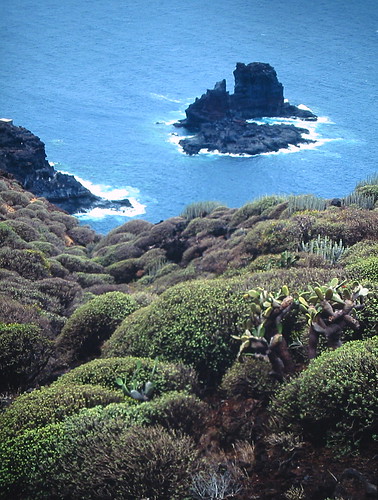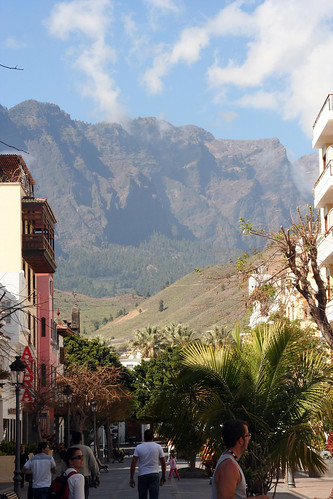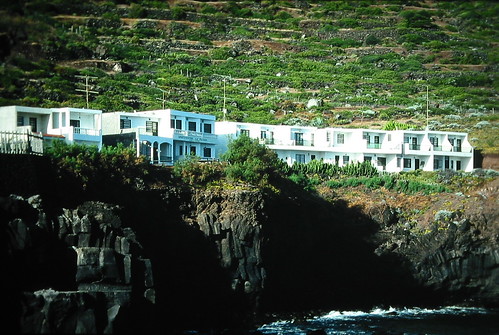Festivals and Flemish art show in a place of surprises. La Palma is impregnated by the parties Lustrales of the Descent of the Virgin, who are now dancing to the endearing dwarf the devilish sounds of a polka. On August 5, The Lady of the Snows Shrine return to its renaissance in the woods, about five kilometers from the capital, before taking off on Saturday. Will have to wait to 2015 for the festive repeat visit.

Photography by pizzodisevo
The profile of La Palma, on the steep ridge its highest point, 2423 meters, at the Roque de los Muchachos, is formed by solid white domes and buildings that look at the sky. All the most important astrophysical observatories in the northern hemisphere, under the Instituto de Astrofisica de Canarias (IAC) offers a program of free visits to the site explaining the operation of the telescopes. You can request information on 922 42 57 28 (from 9.00 to 14.00 hours canaria).
To the south, on the west, the volcano Teneguía was the last to erupt on Spanish soil. It happened in 1971, caused no damage and only grew the island. The Visitor Center Fuencaliente Volcanoes tells everything. In Fuencaliente salt is extracted using traditional one of the best sea salt and fleur de sel in the world.
Calle Real de Santa Cruz de La Palma is the best example of the monumental palm. In the Renaissance church of El Salvador, the transitional home, say on the morning of August 5 farewell mass, initiating the Gothic image of terra cotta, the fifteenth century, returning to its sanctuary in the gorge of the Snows.
The Plaza of Spain, which opens El Salvador, is flanked by eighteenth-century noble houses and the building Plateresque city hall, XVI: one of the best architectural de Canarias, traversed by cobbled Royal Street, parallel to the sea palatial facade and cut stone, felt, pleasant and leisurely, the island beat.

Photography by Marianne Perdomo
La Palma was the Canary Islands which opened trade with America, also created the initial court here Indies. Its trade with Flanders, from where the first planters established to exploit the sugar mills was also important. The legacy they have left to the clappers of the XXI century, as well as some surnames (Van de Walle, Van Dale, Van Ghemert Monteverde), is the overwhelming presence of Flemish art of the best workshops in Antwerp, Brussels and Mechelen, to Instead, send sugar, embroidery, silk and exquisite wine Malvasia.

Photography by pizzodisevo
The thirty pieces of flamenco (possibly the best set of Spain) are not far apart works of art are part of everyday life and are the subject of deep devotion. This applies to the Virgin de los Remedios de Los Llanos, the sixteenth century, which is celebrated on July 2, and Our Lady of Sorrows, in the same time, also taken in procession every 15 August in around the sanctuary, in the gorge its name, through which the majestic volcanic crater of Caldera is dumped into the ocean. The group chaired by the Cristo del Amparo, considered the most outstanding flamenco ordeal of Spain, also sees the light out of the Snows Shrine of Holy Week, while it does Our Lady of Mercy down in the city. La Virgen del Rosario in the distance provides the Moors and Christians in Barlovento, in August, Santa Lucia leaves his hermitage Puntallana in December, San Blas it does in Villa de Mazo on 3 February and the Virgin of Candelaria in September Tijarafe.

Photography by jtoledo
Flemish carvings are also in Brena Baja, San Andrés y Sauces and Tazacorte several temples in the capital and one of them, Santo Domingo, also houses an extraordinary collection of paintings from the same period.
To the west, in Los Llanos, contemporary art has appropriated their urban medians on a project, The City in the Museum, begun in 1999 and has brought to this small island works, including Andres Rabago (El Roto ) Ceesepe, Ouka Leele and Javier Mariscal. On the other hand the art of silk is preserved here as elsewhere in Spain.

Photography by pizzodisevo
On August 15 will be held in an extraordinary way, the representation of Muslims and Christians in Windward, the next will be in 2013. Horses Fuscos dance (do biennially) on 21 August in his polka Fuencaliente horses in the light of torches. On September 7, after midnight, the devil Tijarafe interrupted, protected by a casing and wrapped in fireworks, the festival of the square is the failure of malignant festive hours before the procession leaves the Virgin of Candelaria.
Leave a Reply
You must be logged in to post a comment.
Recent Comments